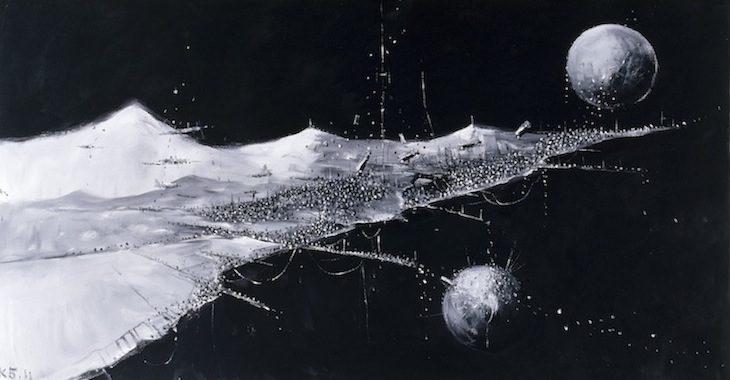Russian Cosmos
Francisco Infante, Konstantin Batynkov, Pavel Pepperstein
Turin, 16.12.2011—26.02.2012
exhibition is over
Castello di Rivoli Museo d'Arte Contemporanea
(
Piazza Mafalda di Savoia,
10098 Rivoli Torino, Italy,
Share with friends
Curator: Olga Sviblova
Research: Olesia Turkina
For the press
The Exhibition “Russian Cosmos” is set up as part of the Year of Italian Language and Italian Culture in Russia, and the Year of Russian Language and Russian Culture in Italy. It is connected with the 50th anniversary of the first flight of a human being into space. It embodies an effort to analyze the ties between the notions of Cosmism, created by Russian philosophers, scientists, writers and artists in the early 20th century and Russian contemporary art.
The vast geographic scope, the harsh climate and the innate ability of the Russian people to dream, as well as their religious faith in the forthcoming heaven, whatever the present living conditions, are the background for the appearance of the ideas of Cosmism and of dreams regarding the conquest of outer space. The religious philosopher Nikolai Feodorov (1829-1903) became the first to come up with certain concepts that eventually led to the emergence of Cosmism. At the basis of his theory there was lying a belief in the possibility of common scientific and practical work, done by all the inhabitants of the Earth, aimed at physically reviving their deceased ancestors, as well as the future settlement of the revived and presently existing human beings in outer space. Feodorov’s philosophical notions were further developed by his disciple – the great Russian scientist Constantine Tsyolkovski (1857-1935). He was the one who created the scientific foundation for the subsequent era of space flights, at the same time conceiving the theory of the rayonist transformation of mankind, which would give it an opportunity of eternal life and unlimited possibilities to travel in outer space.
In Russia the ideas connected with the future always predominated over those involved only with the present. In the early 20th century they became a source of inspiration for Russian Avant-Garde writers and painters – the poet Velimir Khlebnikov, artists Kazimir Malevich, Alexander Rodchenko, Vladimir Tatlin, Ilia Chashnik, Vladimir Sterligov, Nikolai Suetin, Vasili Chekrygin and others. In 1922 Chekrygin, for example, creates a special cycle “Resurrection”, devoted to Feodorov’s ideas. The aesthetics of Russian Avant-Garde, on the whole, reflected an effort of visually embodying the concepts of the movement towards a beautiful future, connected not solely with transforming reality, but more so with conquering the infinite cosmic space.
Projects of the Russian scientist Sergei Koroliov (1906/1907-1966), whose technological research was inspired by these Utopian ideas, led to the Soviet Union successfully launching the first satellite and the first manpowered ship into outer space. After the October revolution of 1917, the new Soviet Power was at first actively supporting both Russian Avant-Garde and scientific research connected with the ideas of transforming the future. However, already in the 1930s the advance of totalitarianism led to a state of confrontation between Avant-Garde ideas and the totalitarian ideological system. Russian Avant-Garde artists became something superfluous in the epoch of Socialist Realism, which was imposed by directives coming from the new authorities. At the same time many scientists, including Koroliov himself, were imprisoned during the “reign” of Stalin. The post-war Soviet Union, which emerged triumphant, but was behind the West in terms of technology, wanted to be ahead of others. After the death of Stalin the authorities encouraged the persecuted scientists to return to their research work, reviving the idea of conquering outer space, which thus became not just a technological, but an ideological myth. In 1957 this myth turns into reality – the USSR is launching the first space sputnik. In 1961 the Soviet Union and the whole world are stunned by the news of the first man rocketed into outer space.
The project “Russian Cosmos” unites within a single exhibition space the compositions created by Russian Avant-Garde artists, the works of scientists like Constantine Tsiolkovski, with the oeuvre of later Russian artists, beginning with the epoch of Khrushchev’s “Thaw” (after 1956) up to the present. Francisco Infante’s series “The Project of the Reconstruction of the Starry Sky” (1965-1967) illustrates a new level of interpreting the ideas of Russian Avant-Garde by the post-war generation of artists, who were “cut off” from the former by the ban on Russian Avant-Garde inside the Soviet Union itself. On the one hand, we see the plastic system of Russian Avant-Garde being revived, on the other, the author takes a different look at the very idea of transforming the world, even when it is connected with the Project of its universal improvement. This was a post-totalitarian reaction of the generation which witnessed Khrushchev’s criticism of Stalin’s totalitarianism. As a result the work of Francisco Infante appears to represent the dualism of a romantic and ironic attitude towards the Suprematist ideas of those who preceded him in the early 20th century.
Cosmism was the only Soviet myth, actively imposed in the USSR since the mid-1920s, which retains its energy up to the present. It was this myth, with its feats, that inspired several generations of Soviet children to form their ideals regarding heroism. For example, in the course of several decades playgrounds for children in cities and towns were adorned with rockets and other attributes of space flights that nourished the childhood dream of becoming an astronaut. The young photographer Ivan Mikhailov made these romantic dreams the object of his cycle “Playground” (2010). Galactic holes turn out to be the focus of one of the leaders of Russian contemporary art, Pavel Pepershtein, in his compositions of the series “Space Holes” (2011). The gurus of the contemporary international and Russian art scenes, Ilia and Emilia Kabakov, create their own version of space mythology – the cycle “Center of Cosmic Energy” (2003). These compositions seem to be a direct response to Constantine Tsyolkovski’s drawings “The Album of Space Voyages” (1933), accompanying the cult movie “The Space Flight” (1935), which became one of the sources of inspiration not only for many Soviet people, but also for Kubrick and for Lucas. These drawings by Tsyolkovski, just as a model of a zeppelin that he made and a trumpet “for listening to the music of the spheres” , coming from his little house outside Kaluga, where the great scientist lived all his life, are for the first time shown before a wide audience. The works of Constantine Batynkov from the series “Cosmos” (2011) continue the dialogue with Feodorov’s notions regarding human settlements in outer space.
The cosmic myth managed to live on through the epoch of total demythologization of Soviet myths, which accompanied Gorbachev’s perestroika of the late 1980s. It now becomes a source of inspiration for the new St. Petersburg artists – Timur Novikov, the Group “ASSA” (Timur Novikov, Georgi Ostretsov, Ivan Sotnikov, Oleg Kotelnikov), as well as for Andrei Krisanov, Ilia Kitup, Igor Verichev (the “New Composers” Group), Dmitri Gutov and others. After the collapse of the Soviet Union in 1991 the cosmic myth survives through all the difficulties. Being interpreted in an ironic or a romantic manner, it still finds its reflection today in the works of Sergei Shutov, the “Blue Noses” Group, Margo Trushina and others.
At present, in the era of total demythologization, the cosmic myth still remains a source of vital energy and gives some hope of overcoming the global crisis in which our world has found itself.





